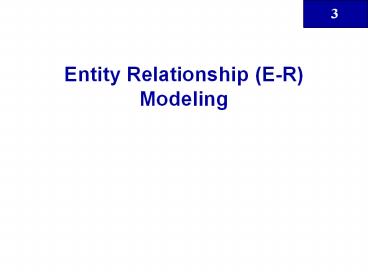Entity Relationship (E-R) Modeling - PowerPoint PPT Presentation
Title:
Entity Relationship (E-R) Modeling
Description:
... external models serve the database design process How ... Established Fourth and Fifth ERD Segments Established ... & Management, 5th Edition, ... – PowerPoint PPT presentation
Number of Views:402
Avg rating:3.0/5.0
Title: Entity Relationship (E-R) Modeling
1
Entity Relationship (E-R) Modeling
2
In this lecture, you will learn
- What a conceptual model is and what its purpose
is - The difference between internal and external
models - How internal and external models serve the
database design process - How relationships between entities are defined
and refined, and how such relationships are
incorporated into the database design process - How ERD components affect database design and
implementation - How to interpret the modeling symbols for the
four most popular E-R modeling tools - That real-world database design often requires
you to reconcile conflicting goals
3
Basic Modeling Concepts
- Art and science
- Good judgment coupled with powerful design tools
- Models
- Description or analogy used to visualize
something that cannot be directly observed
Websters Dictionary - Data Model
- Relatively simple representation of complex
real-world data structures
4
Data Models Degrees of Data Abstraction
5
Degrees of Abstraction
- Conceptual
- Global view of data
- Basis for identification and description of main
data items - ERD used to represent conceptual data model
- Hardware and software independent
- Internal
- Representation of database as seen by DBMS
- Adapts conceptual model to specific DBMS
- Software dependent
6
Degrees of Abstraction (cont.)
- External
- Users views of data environment
- Provides subsets of internal view
- Makes application program development easier
- Facilitates designers tasks
- Ensures adequacy of conceptual model
- Ensures security constraints in design
- Physical
- Lowest level of abstraction
- Software and hardware dependent
- Requires definition of physical storage devices
and access methods
7
The Entity Relationship (E-R) Model
- Represents conceptual view
- Main Components
- Entities
- Corresponds to entire table, not row
- Represented by rectangle
- Attributes
- Relationships
8
Attributes
- Characteristics of entities
- Domain is set of possible values
- Primary keys underlined
9
Attributes (cont.)
- Simple
- Cannot be subdivided
- Age, sex, marital status
- Composite
- Can be subdivided into additional attributes
- Address into street, city, zip
- Single-valued
- Can have only a single value
- Person has one social security number
- Multi-valued
- Can have many values
- Person may have several college degrees
- Derived
- Can be derived with algorithm
- Age can be derived from date of birth
10
Relationships
- Association between entities
- Connected entities are called participants
- Operate in both directions
- Connectivity describes relationship
classification - 11, 1M, MN
- Cardinality
- Expresses number of entity occurrences associated
with one occurrence of related entity
11
Connectivity and Cardinality in an ERD
12
Relationship Strength
- Existence dependence
- Entitys existence depends on existence of
related entities - Existence-independent entities can exist apart
from related entities - EMPLOYEE claims DEPENDENT
- Weak (non-identifying)
- One entity is existence-independent on another
- PK of related entity doesnt contain PK component
of parent entity - Strong (identifying)
- One entity is existence-dependent on another
- PK of related entity contains PK component of
parent entity
13
Relationship Participation
- Optional
- Entity occurrence does not require a
corresponding occurrence in related entity - Shown by drawing a small circle on side of
optional entity on ERD - Mandatory
- Entity occurrence requires corresponding
occurrence in related entity - If no optionality symbol is shown on ERD, it is
mandatory
14
Weak Entity
- Existence-dependent on another entity
- Has primary key that is partially or totally
- derived from parent entity
15
Relationship Degree
- Indicates number of associated entities
- Unary
- Single entity
- Recursive
- Exists between occurrences of same entity set
- Binary
- Two entities associated
- Ternary
- Three entities associated
16
Three Types of Relationships
17
Composite Entities
- Used to bridge between MN relationships
- Bridge entities composed of primary keys of each
entity needing connection
18
Composite Entities (cont.)
19
Entity Supertypes and Subtypes
- Generalization hierarchy
- Depicts relationships between higher-level
supertype and lower-level subtype entities - Supertype has shared attributes
- Subtypes have unique attributes
- Disjoint relationships
- Unique subtypes
- Non-overlapping
- Indicated with a G
- Overlapping subtypes use Gs Symbol
20
Generalization Hierarchy with Overlapping Subtypes
21
Comparison of E-R Modeling Symbols
- Alternate styles developed to enable easier use
of CASE tools - Chen
- Moved conceptual design into practical database
design arena - Crows Foot
- Cannot detail all cardinalities
- Rein85
- Similar to Crows Foot
- Operates at higher level of abstraction
- IDEF1X
- Derivative of ICAM studies in the late 1970s
- Uses fewer symbols
22
Comparison of E-R Modeling Symbols
23
Developing an E-R Diagram
- Iterative Process
- Step1 General narrative of organizational
operations developed - Step2 Basic E-R Model graphically depicted and
reviewed - Step3 Modifications made to incorporate newly
discovered E-R components - Repeat process until designers and users agree
E-R Diagram complete
24
Supertype/Subtype Relationship in an ERD
25
First ERD Segment Established
26
Second and Third ERD Segments Established
27
Fourth and Fifth ERD Segments Established
28
Sixth and Seventh ERD Segments Established
29
Eighth ERD Segment Established
30
Ninth ERD Segment Established
31
Components of E-R Model
32
Completed ERD
33
Challenge of Database Design Conflicting Goals
- Database must be designed to conform to design
standards - High-speed processing may require design
compromises - Quest for timely information may be the focus of
database design - Other concerns
- Security
- Performance
- Shared access
- Integrity































